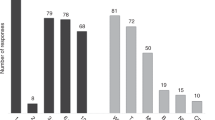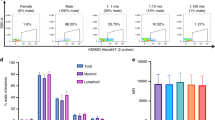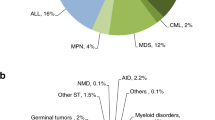Abstract
The analysis of chimerism is crucial to determine the status of patients receiving hematopoietic stem cell transplantation. The variety of relevant techniques available today range from those that analyse nucleic acids (i.e. polymerase chain reaction based, next generation sequencing) and cellular phenotype (i.e. flow cytometry) to sophisticated imaging (particularly multimodal imaging using labelling agents). However, current developments of advanced therapies bring chimerism studies into a new dimension in which methods for detection of donor cells in the patient need to adapt to a wider range of cell- and gene-based medicines, routes of administration, target organs and pathologies. Herein we describe and analyze the toolkit of suitable labelling and detection methodologies with actual examples along with a discussion on challenges ahead and potential solutions. Remarkably, existing methods commonly used in chimerism analysis are suitable for use with new cell- and gene-based medicines. Indeed, new developments may facilitate the evolution and combination of such methodologies to the use of non-invasive and highly informative approaches.
This is a preview of subscription content, access via your institution
Access options
Subscribe to this journal
Receive 12 print issues and online access
$259.00 per year
only $21.58 per issue
Buy this article
- Purchase on Springer Link
- Instant access to full article PDF
Prices may be subject to local taxes which are calculated during checkout

Similar content being viewed by others
References
Clemente I, Goncalo A, Faria C, Dias M, Barbosa I, Mendes C. Relevance of chimerism analysis after allogeneic stem cell transplantation. Transplant Proc. 2017;49:890–2.
Khan F, Agarwal A, Agrawal S. Significance of chimerism in hematopoietic stem cell transplantation: new variations on an old theme. Bone Marrow Transplant. 2004;34:1–12.
Boráň T, Menezes-Ferreira M, Reischl I, Celis P, Ferry N, Gänsbacher B, et al. Clinical development and commercialization of advanced therapy medicinal products in the European Union: how are the product pipeline and regulatory framework evolving? Hum Gene Ther Clin Dev. 2017;28:126–35.
Salmikangas P, Schuessler-Lenz M, Ruiz S, Celis P, Reischl I, Menezes-Ferreira M, et al. Marketing regulatory oversight of advanced therapy medicinal products (ATMPs) in Europe: the EMA/CAT perspective. Adv Exp Med Biol. 2015;871:103–30.
Fischbach MA, Bluestone JA, Lim WA. Cell-based therapeutics: the next pillar of medicine. Sci Transl Med. 2013;5:179ps7.
Cuende N, Rasko JEJ, Koh MBC, Dominici M, Ikonomou L. Cell, tissue and gene products with marketing authorization in 2018 worldwide. Cytotherapy. 2018;20:1401–13.
Naji A, Eitoku M, Favier B, Deschaseaux F, Rouas-Freiss N, Suganuma N. Biological functions of mesenchymal stem cells and clinical implications. Cell Mol Life Sci. 2019;76:3323–48.
June CH, Sadelain M. Chimeric antigen receptor therapy. N Engl J Med. 2018;379:64–73.
Vives J, Mirabel C. Multipotent mesenchymal stromal cells from bone marrow for current and potential clinical applications. In: Reis RL, editor. Encyclopedia of tissue engineering and regenerative medicine. Oxford: Academic Press; 2019. p. 503–12.
Vives J, Carmona G, Vives J, Carmona G. Guide to cell therapy GxP. 1st ed. London: Academic Press (Elsevier); 2015.
Sharma R. Stem cells and tissue engineering in medical practice. Curr Drug Targets. 2018;388–98.
CAT, Schneider CK, Salmikangas P, Jilma B, Flamion B, Todorova LR, et al. Challenges with advanced therapy medicinal products and how to meet them. Nat Rev Drug Discov. 2010;9:195–201.
Li SC, Tachiki LM, Luo J, Dethlefs BA, Chen Z, Loudon WG. A biological global positioning system: considerations for tracking stem cell behaviors in the whole body. Stem Cell Rev. 2010;6:317–33.
Reyes B, Coca MI, Codinach M, Lopez-Lucas MD, Del Mazo-Barbara A, Caminal M, et al. Assessment of biodistribution using mesenchymal stromal cells: Algorithm for study design and challenges in detection methodologies. Cytotherapy. 2017;19:1060–9.
van Dijk BA, Drenthe-Schonk AM, Bloo A, Kunst VA, Janssen JT, de Witte TJ. Erythrocyte repopulation after allogeneic bone marrow transplantation. Analysis using erythrocyte antigens. Transplantation. 1987;44:650–4.
Hendriks EC, de Man AJ, van Berkel YC, Stienstra S, de Witte T. Flow cytometric method for the routine follow-up of red cell populations after bone marrow transplantation. Br J Haematol. 1997;97:141–5.
Schaap N, Schattenberg A, Bar B, Mensink E, de Man A, Geurts van Kessel A, et al. Red blood cell phenotyping is a sensitive technique for monitoring chronic myeloid leukaemia patients after T-cell-depleted bone marrow transplantation and after donor leucocyte infusion. Br J Haematol. 2000;108:116–25.
Piagnerelli M, Zouaoui Boudjeltia K, Brohee D, Vereerstraeten A, Piro P, Vincent JL, et al. Assessment of erythrocyte shape by flow cytometry techniques. J Clin Pathol. 2007;60:549–54.
Diez B, Genovese P, Roman-Rodriguez FJ, Alvarez L, Schiroli G, Ugalde L, et al. Therapeutic gene editing in CD34(+) hematopoietic progenitors from Fanconi anemia patients. EMBO Mol Med. 2017;9:1574–88.
Butturini A, Gale RP, Verlander PC, Adler-Brecher B, Gillio AP, Auerbach AD. Hematologic abnormalities in Fanconi anemia: an International Fanconi Anemia Registry study. Blood. 1994;84:1650–5.
Río P, Navarro S, Wang W, Sánchez-Domínguez R, Pujol RM, Segovia JC, et al. Successful engraftment of gene-corrected hematopoietic stem cells in non-conditioned patients with Fanconi anemia. Nat Med. 2019;25:1396–401.
Wilkins O, Keeler AM, Flotte TR. CAR T-cell therapy: progress and prospects. Hum Gene Ther Methods. 2017;28:61–6.
Zheng Z, Chinnasamy N, Morgan RA. Protein L: a novel reagent for the detection of chimeric antigen receptor (CAR) expression by flow cytometry. J Transl Med. 2012;10:29.
Zhang C, Wang Z, Yang Z, Wang M, Li S, Li Y, et al. Phase I escalating-dose trial of CAR-T therapy targeting CEA. Mol Ther. 2017;25:1248–58.
Jólkowska J, Pieczonka A, Strabel T, Boruczkowski D, Wachowiak J, Bader P, et al. Hematopoietic chimerism after allogeneic stem cell transplantation: a comparison of quantitative analysis by automated DNA sizing and fluorescent in situ hybridization. BMC Blood Disord. 2005;5:1.
Erlecke J, Hartmann I, Hoffmann M, Kroll T, Starke H, Heller A, et al. Automated detection of residual cells after sex-mismatched stem-cell transplantation - evidence for presence of disease-marker negative residual cells. Mol Cytogenet. 2009;2:12.
Dewald GW, Schad CR, Christensen ER, Law ME, Zinsmeister AR, Stalboerger PG, et al. Fluorescence in situ hybridization with X and Y chromosome probes for cytogenetic studies on bone marrow cells after opposite sex transplantation. Bone Marrow Transplant. 1993;12:149–54.
Hibi S, Tsunamoto K, Todo S, Sawada T, Ueda Y, Taniwaki M, et al. Chimerism analysis on mononuclear cells in the CSF after allogeneic bone marrow transplantation. Bone Marrow Transplant. 1997;20:503–6.
Buño I, Nava P, Simón A, González-Rivera M, Jiménez JL, Balsalobre P, et al. A comparison of fluorescent in situ hybridization and multiplex short tandem repeat polymerase chain reaction for quantifying chimerism after stem cell transplantation. Haematologica. 2005;90:1373–9.
Chaterji S, Ahn EH, Kim DH. CRISPR genome engineering for human pluripotent stem cell research. Theranostics. 2017;7:4445–69.
Chen B, Gilbert LA, Cimini BA, Schnitzbauer J, Zhang W, Li GW, et al. Dynamic imaging of genomic loci in living human cells by an optimized CRISPR/Cas system. Cell. 2013;155:1479–91.
Deng W, Shi X, Tjian R, Lionnet T, Singer RH. CASFISH: CRISPR/Cas9-mediated in situ labeling of genomic loci in fixed cells. Proc Natl Acad Sci USA. 2015;112:11870–5.
Poloni A, Leoni P, Buscemi L, Balducci F, Pasquini R, Masia MC, et al. Engraftment capacity of mesenchymal cells following hematopoietic stem cell transplantation in patients receiving reduced-intensity conditioning regimen. Leukemia. 2006;20:329–35.
Fujisawa M, Hayashi K, Nishio T, Bando T, Okada S, Yamato KT, et al. Isolation of X and Y chromosome-specific DNA markers from a liverwort, Marchantia polymorpha, by representational difference analysis. Genetics. 2001;159:981–5.
Yamane A, Karasawa M, Maehara T, Tsukamoto N, Nojima Y. X chromosome methylation-based chimerism assay for sex-mismatched hematopoietic stem cell transplantation. Bone Marrow Transplant. 2001;28:969–73.
Aloisio M, Licastro D, Caenazzo L, Torboli V, D’Eustacchio A, Severini GM, et al. A technical application of quantitative next generation sequencing for chimerism evaluation. Mol Med Rep. 2016;14:2967–74.
Kletzel M, Huang W, Olszewski M, Khan S. Validation of chimerism in pediatric recipients of allogeneic hematopoietic stem cell transplantation (HSCT) a comparison between two methods: real-time PCR (qPCR) vs. variable number tandem repeats PCR (VNTR PCR). Chimerism. 2013;4:1–8.
Alizadeh M, Bernard M, Danic B, Dauriac C, Birebent B, Lapart C, et al. Quantitative assessment of hematopoietic chimerism after bone marrow transplantation by real-time quantitative polymerase chain reaction. Blood. 2002;99:4618–25.
Kuang J, Yan X, Genders AJ, Granata C, Bishop DJ. An overview of technical considerations when using quantitative real-time PCR analysis of gene expression in human exercise research. PLoS ONE. 2018;13:e0196438.
Kim SY, Jeong MH, Park N, Ra E, Park H, Seo SH, et al. Chimerism monitoring after allogeneic hematopoietic stem cell transplantation using quantitative real-time PCR of biallelic insertion/deletion polymorphisms. J Mol Diagn. 2014;16:679–88.
Jimenez-Velasco A, Barrios M, Roman-Gomez J, Navarro G, Buno I, Castillejo JA, et al. Reliable quantification of hematopoietic chimerism after allogeneic transplantation for acute leukemia using amplification by real-time PCR of null alleles and insertion/deletion polymorphisms. Leukemia. 2005;19:336–43.
Thiede C, Bornhauser M, Ehninger G. Strategies and clinical implications of chimerism diagnostics after allogeneic hematopoietic stem cell transplantation. Acta Haematol. 2004;112:16–23.
Huggett JF, Cowen S, Foy CA. Considerations for digital PCR as an accurate molecular diagnostic tool. Clin Chem. 2015;61:79–88.
Kliman D, Castellano-Gonzalez G, Withers B, Street J, Tegg E, Mirochnik O, et al. Ultra-sensitive droplet digital PCR for the assessment of microchimerism in cellular therapies. Biol Blood Marrow Transplant. 2018;24:1069–78.
Mika T, Baraniskin A, Ladigan S, Wulf G, Dierks S, Haase D, et al. Digital droplet PCR-based chimerism analysis for monitoring of hematopoietic engraftment after allogeneic stem cell transplantation. Int J Lab Hematol. 2019;41:615–21.
Valero-Garcia J, González-Espinosa MDC, Barrios M, Carmona-Antoñanzas G, García-Planells J, Ruiz-Lafora C, et al. Earlier relapse detection after allogeneic haematopoietic stem cell transplantation by chimerism assays: digital PCR versus quantitative real-time PCR of insertion/deletion polymorphisms. PLoS ONE. 2019;14:e0212708.
Lin HT, Okumura T, Yatsuda Y, Ito S, Nakauchi H, Otsu M. Application of droplet digital PCR for estimating vector copy number states in stem cell gene therapy. Hum Gene Ther Methods. 2016;27:197–208.
Jin W, Liang X, Brooks A, Futrega K, Liu X, Doran MR, et al. Modelling of the SDF-1/CXCR4 regulated. PeerJ. 2018;6:e6072.
Gu E, Chen WY, Gu J, Burridge P, Wu JC. Molecular imaging of stem cells: tracking survival, biodistribution, tumorigenicity, and immunogenicity. Theranostics. 2012;2:335–45.
Mukherjee A, Tipnis S, Sarma HD, Ravindran G, Samuel G, Viswanathan C, et al. Radiolabeling of umbilical cord-derived mesenchymal stem cells for in vivo tracking. Cancer Biother Radiopharm. 2012;27:614–9.
Giarratana MC, Rouard H, Dumont A, Kiger L, Safeukui I, Le Pennec PY, et al. Proof of principle for transfusion of in vitro-generated red blood cells. Blood. 2011;118:5071–9.
Cheng SH, Yu D, Tsai HM, Morshed RA, Kanojia D, Lo LW, et al. Dynamic in vivo SPECT imaging of neural stem cells functionalized with radiolabeled nanoparticles for tracking of glioblastoma. J Nucl Med. 2016;57:279–84.
Kurpisz M, Czepczyński R, Grygielska B, Majewski M, Fiszer D, Jerzykowska O, et al. Bone marrow stem cell imaging after intracoronary administration. Int J Cardiol. 2007;121:194–5.
Serganova I, Ponomarev V, Blasberg R. Human reporter genes: potential use in clinical studies. Nucl Med Biol. 2007;34:791–807.
Gholamrezanezhad A, Mirpour S, Bagheri M, Mohamadnejad M, Alimoghaddam K, Abdolahzadeh L, et al. In vivo tracking of 111In-oxine labeled mesenchymal stem cells following infusion in patients with advanced cirrhosis. Nucl Med Biol. 2011;38:961–7.
Ringden O, Uzunel M, Rasmusson I, Remberger M, Sundberg B, Lonnies H, et al. Mesenchymal stem cells for treatment of therapy-resistant graft-versus-host disease. Transplantation. 2006;81:1390–7.
Vo D, Nguyen PK. Multimodality molecular imaging in cardiac regenerative therapy. J Nucl Cardiol. 2017;24:1803–9.
Brooks A, Futrega K, Liang X, Hu X, Liu X, Crawford DHG, et al. Concise review: quantitative detection and modeling the in vivo kinetics of therapeutic mesenchymal stem/stromal cells. Stem Cells Transl Med. 2018;7:78–86.
Ahrens ET, Bulte JW. Tracking immune cells in vivo using magnetic resonance imaging. Nat Rev Immunol. 2013;13:755–63.
Wu B, Warnock G, Zaiss M, Lin C, Chen M, Zhou Z, et al. An overview of CEST MRI for non-MR physicists. EJNMMI Phys. 2016;3:19.
Janowski M, Walczak P, Kropiwnicki T, Jurkiewicz E, Domanska-Janik K, Bulte JW, et al. Long-term MRI cell tracking after intraventricular delivery in a patient with global cerebral ischemia and prospects for magnetic navigation of stem cells within the CSF. PLoS ONE. 2014;9:e97631.
Gayathri K, Shailendhra K. MRI and blood flow in human arteries: are there any adverse effects? Cardiovasc Eng Technol. 2019;10:242–56.
Kim SJ, Lewis B, Steiner MS, Bissa UV, Dose C, Frank JA. Superparamagnetic iron oxide nanoparticles for direct labeling of stem cells and in vivo MRI tracking. Contrast Media Mol Imaging. 2016;11:55–64.
Kirsch M, Wannez S, Thibaut A, Laureys S, Brichant JF, Bonhomme V. Positron emission tomography: basic principles, new applications, and studies under anesthesia. Int Anesthesiol Clin. 2016;54:109–28.
Hsu MJ, Prigent J, Dollet PE, Ravau J, Larbanoix L, Van Simaeys G, et al. Long-term in vivo monitoring of adult-derived human liver stem/progenitor cells by bioluminescence imaging, positron emission tomography, and contrast-enhanced computed tomography. Stem Cells Dev. 2017;26:986–1002.
Williams KM, Holter-Chakrabarty J, Lindenberg L, Duong Q, Vesely SK, Nguyen CT, et al. Imaging of subclinical haemopoiesis after stem-cell transplantation in patients with haematological malignancies: a prospective pilot study. Lancet Haematol. 2018;5:e44–52.
Hancock JP, Burgess MF, Goulden NJ, Steward CG, Knechtli CJ, Pamphilon DH, et al. Same-day determination of chimaeric status in the immediate period following allogeneic bone marrow transplantation. Br J Haematol. 1997;99:403–9.
Nakao S, Nakatsumi T, Chuhjo T, Ohtaguro M, Tsuchiya H, Niki T, et al. Analysis of late graft failure after allogeneic bone marrow transplantation: detection of residual host cells using amplification of variable number of tandem repeats loci. Bone Marrow Transplant. 1992;9:107–11.
Zeineldin R. 7—Nanotechnology for cancer screening and diagnosis. In: Park K, editor. Biomaterials for Cancer Therapeutics: Woodhead Publishing; 2013. p. 137–64.
Hicks R, Lau E, Binns D. Hybrid imaging is the future of molecular imaging. Biomed Imaging Interv J. 2007;3:e49.
Ruf J, Lopez Hänninen E, Böhmig M, Koch I, Denecke T, Plotkin M, et al. Impact of FDG-PET/MRI image fusion on the detection of pancreatic cancer. Pancreatology. 2006;6:512–9.
Catana C, Wu Y, Judenhofer MS, Qi J, Pichler BJ, Cherry SR. Simultaneous acquisition of multislice PET and MR images: initial results with a MR-compatible PET scanner. J Nucl Med. 2006;47:1968–76.
Sensebé L, Fleury-Cappellesso S. Biodistribution of mesenchymal stem/stromal cells in a preclinical setting. Stem Cells Int. 2013;2013:678063.
Huang T, Deng CX. Current progresses of exosomes as cancer diagnostic and prognostic biomarkers. Int J Biol Sci. 2019;15:1–11.
Acknowledgements
We are grateful to Dr Belén Ansoleaga for critically reviewing the paper. This work has been developed in the context of ADVANCE(CAT) with the support of ACCIÓ (Catalonia Trade & Investment; Generalitat de Catalunya) and the European Community under the Catalonian ERDF operational programme (European Regional Development Fund) 2014–2020, Generalitat de Catalunya (Departament de Salut) PERIS Acció Instrumental de Programes de Recerca Orientats (SLT002/16/00234) and by the Spanish Cell Therapy Network (TerCel, expedient number: RD16/0011/0028). Project PI19/01788 is funded by Instituto de Salud Carlos III and co-funded by European Union (ERDF/ESF)—a way to build Europe. JV’s laboratory is awarded by the Generalitat de Catalunya as Consolidated Research Group (ref. 2017SGR719). NN has been supported by Fundació La Marató de TV3 (File number 20133230).
Author information
Authors and Affiliations
Contributions
JV and NN conceived the study; JV, AC-R, LM and NN collected information, wrote the paper and approved the final version.
Corresponding author
Ethics declarations
Conflict of interest
The authors declare that they have no conflict of interest.
Additional information
Publisher’s note Springer Nature remains neutral with regard to jurisdictional claims in published maps and institutional affiliations.
Rights and permissions
About this article
Cite this article
Vives, J., Casademont-Roca, A., Martorell, L. et al. Beyond chimerism analysis: methods for tracking a new generation of cell-based medicines. Bone Marrow Transplant 55, 1229–1239 (2020). https://doi.org/10.1038/s41409-020-0822-8
Received:
Revised:
Accepted:
Published:
Issue Date:
DOI: https://doi.org/10.1038/s41409-020-0822-8
This article is cited by
-
Can novel methods replace the gold standard chimerism method after allogeneic hematopoietic stem cell transplantation?
Annals of Hematology (2024)
-
Transitioning single-cell genomics into the clinic
Nature Reviews Genetics (2023)
-
Evaluation of a quantitative PCR-based method for chimerism analysis of Japanese donor/recipient pairs
Scientific Reports (2022)



